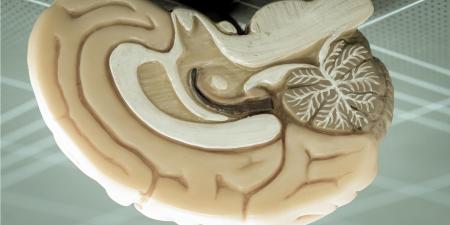Case
Neurologist Dr. Biels was asked to evaluate Neal Boland, a 67-year-old, right-handed man with a long history of poorly controlled hypertension and hyperlipidemia. Mr. Boland was discovered by his wife to be sitting unresponsive in his armchair when she returned from an afternoon of shopping. Upon arrival of the EMT, he opened his eyes and moved his left arm and leg in agitation, but did not move his right. In the ER, he was mute and stuporous, unresponsive to voice, arousing only briefly to painful nailbed stimulation of the left hand and foot. Fundoscopic exam was normal. Pupillary responses, corneal reflexes, and gag were normal. Severe right facial weakness was noted. Occasional spontaneous left upper and lower extremity movements continued, but flaccid right hemiplegia persisted. Head CT scan was normal. His attending physician, an internist, consulted Dr. Biels, a neurologist, who documented a Glasgow Coma Score of 9 (eye 4, verbal 1, motor 4).
In the following days, Mr. Boland's neurological examination improved slightly. He began to have sleeping and waking periods and to open his eyes spontaneously. He occasionally seemed to smile when visitors or staff entered the room and squeezed his wife's finger several times, but not on command. His gag reflex remained weak, and a nasogastric feeding tube was placed. A follow-up CT scan 48 hours after admission confirmed a large left frontoparietal infarct with significant edema, likely resulting from left middle cerebral artery occlusion.
Mr. Boland's condition changed minimally over the next ten days. Caregivers were able to move him to a chair for short periods in the morning and afternoon. His wife, who was his only family member, became concerned at his lack of progress, since he still did not recognize her and could not communicate. Although Mr. Boland had no advance directive, Mrs. Boland said that they had discussed "that woman in Florida" when it was in the news—"lying there for years while her husband and parents fight over her." Neither of them wanted to be kept alive if they had to live "like that woman in Florida."
When Mrs. Boland asked about her husband's prognosis—specifically whether he would be able to eat, recognize her, and interact with his surroundings, "you know, watch television or play with our dog,"—the attending internist was optimistic, saying "it can take a long time for recovery and rehabilitation after a stroke like this." He cited Mr. Boland's stable vital signs and encouraged hope for some improvement. Mr. Boland's other health care team members reinforced this view. Mrs. Boland was told that her husband would have to have a percutaneous endoscopic gastrostomy (PEG) tube placed, to permit long-term feeding, and be transferred to a long-term nursing facility.
The next time Dr. Biels checked on her husband, Mrs. Boland asked his opinion. Based on several additional CT scans that showed extensive, irreversible hemispheric injury, and on the patient's lack of significant progress to date, Dr. Biels doubted that Mr. Boland would make significant neurologic gains, even with extensive rehabilitation efforts and nursing care. Moreover, his condition might worsen acutely if common infectious or cardiorespiratory complications were to occur, as is often the case in such severely impaired patients. If this occurred, Dr. Biels told Mrs. Boland, the physicians would ordinarily employ aggressive medical therapies to give him more time to recover neurologically, but the outcome was not likely to be good, mortality in such cases being as high as 20-40 percent at 3-6 months in many studies. He shared this information compassionately with Mrs. Boland and answered her questions slowly and honestly. Mrs. Boland seemed to understand the prognosis, and then said that she felt overwhelmed by the decisions she had to make about his care. Dr. Biels asked whether she had talked to the chaplain or had a spiritual advisor who could help.
"It's not the spiritual part that bothers me," she said. "If he's going to stay like this, I know he would not want to. Are you certain he will stay like this? The other doctors seemed to think I should give him some more time to recover. I just want some advice about what to do. We've signed a DNR, but where do we draw the line? We can't just stop feeding him, can we? I just keep praying that he dies without us doing anything about it."
Commentary
Unfortunately, Mrs. Boland's dilemma and the distress it causes her are not uncommon in today's hospitals. Mr. Boland's massive left hemispheric stroke has left him with global aphasia, right hemiplegia, and severe dysphagia. Although his internist appears to be optimistic about his long-term prognosis, his neurologist indicates he is unlikely to recover significant neurological function, and quotes a 3-6 month mortality of 20-40 percent, even with continued medical treatment. Faced with an uncertain prognosis for her husband, Mrs. Boland is understandably confused as to what decision to make, and even as to what decisions she can make.
Mr. Boland's global aphasia renders him unable to make decisions about his medical care. Because he has no advance directives, his wife is his appropriate surrogate decision maker. She should do her best to make decisions for him employing a substituted judgment standard. His statements about "that woman in Florida" (ie, Terri Schaivo) may well provide her some guidance in this effort. If she is unable to make a substituted judgment, she should make her decision based on what she perceives as his best interests. Mrs. Boland is faced with 2 major issues: first, what is Mr. Boland's prognosis and, second, what decisions can she and should she make with regard to his medical care.
Although Mrs. Boland appears to have received differing opinions on her husband's prognosis, the difference is really more a matter of emphasis than substance. His internist emphasized the hope for improvement after extended rehabilitation, without quantifying the probabilities. In contrast, while not excluding the possibility of significant recovery, Dr. Biels emphasized the far greater likelihood that he would fail to improve significantly, or even die. Better communication between the two doctors, and even a joint meeting with the 2 of them and Mrs. Boland, might have averted this problem and minimized her confusion. Unfortunately, almost all prognoses can only be given as probabilities, so it is important for physicians to acknowledge the uncertainty and to try to be as realistic about the probabilities as possible.
Mrs. Boland is confident that: "If [Mr. Boland is] going to stay like this, I know he would not want to." Yet she can't be certain that he will not improve significantly. Thus she finds herself in the uncomfortable position of facing difficult life-and-death decisions in the face of her uncertainty. What would Mr. Boland be willing to tolerate, and for how long, for a small chance of significant neurological recovery?
Before discussing particular treatment options, her doctors should help her to consider the goals of treatment. Once the goals of treatment are established, the physicians can recommend treatments that will help advance those goals and explain why other treatments are unlikely to be beneficial. Mrs. Boland's first goal, understandably, is that her husband recover all or most of his neurological function. Unfortunately that is unlikely to happen. If this goal is not achievable, she has indicated that he would not want to be kept alive indefinitely in his current debilitated condition. Although placing a PEG tube is necessary to permit whatever small chance he has for recovery, it is more likely to maintain him in his current condition. Not placing the PEG tube, in contrast, would eliminate any chance of recovery, but would permit him to die a natural death from the effects of his stroke.
The immediate therapeutic question, then, is whether to place the PEG tube to permit long-term artificial hydration and nutrition. Mrs. Boland has inquired of Dr. Biels: "We can't just stop feeding him, can we?" In fact, not placing a PEG tube is a legal and ethical option. Mr. Boland's dysphagia is the result of his stroke—he can no longer nourish himself by eating and drinking. Thus, if the PEG tube is not placed, he will die from dehydration resulting from the effects of his stroke. The US Supreme Court, in the Cruzan case, established that artificial hydration and nutrition is a form of medical therapy and can be refused by competent or incompetent patients. Because, if competent, Mr. Boland would have a right to refuse the PEG tube, his wife, as his legal surrogate, likewise has a right to refuse it on his behalf.1
Mrs. Boland should be advised that not placing the PEG tube and discontinuing artificial hydration and nutrition is, in fact, a legal and ethical option in this situation. She should also be informed that, if she refuses the PEG tube, Mr. Boland would die of dehydration, a process that can take as long as 1 to 2 weeks. If she refuses the PEG tube, palliative measures, including good mouth care and analgesic and sedative medications, should be provided to assure his comfort. She should be given the option of hospice care either in her home or in an extended care facility.
If she does decide to have the PEG tube placed and Mr. Boland is discharged to rehabilitation, she should be advised of the various decisions that she may need to face in the foreseeable future, so that she can begin to anticipate decisions rather than having to make them on the spur of the moment. For example, if he does develop an infection or other complication, she may refuse additional treatments, such as antibiotics, and palliative measures could be instituted at that time. Furthermore, a decision to place a PEG tube does not preclude the option of discontinuing tube feedings if the hoped-for outcome is not achieved. Thus, after a reasonable period of time, if Mr. Boland shows no significant neurological recovery, artificial hydration and nutrition could be discontinued, to avoid prolonging his life in a condition he indicated he would not want, and palliative care could be instituted.
Because stroke remains the third leading cause of death and a major cause of disability in the United States, families are often confronted with decisions regarding the appropriate treatment for patients like Mr. Boland. Keys to helping families make good decisions include maintaining effective communication among the treating doctors and with the family, providing realistic prognostic information, including the element of uncertainty, and understanding that surrogate decision-makers have the right, on behalf of the patient, to refuse any treatment that does not serve the goals of the patient as understood by the surrogate.
References
-
Bernat JL. The persistent vegetative state and other states of profound brain damage. In: Ethical Issues in Neurology. Newton, Mass: Butterworth-Heinemann; 1994:159.



